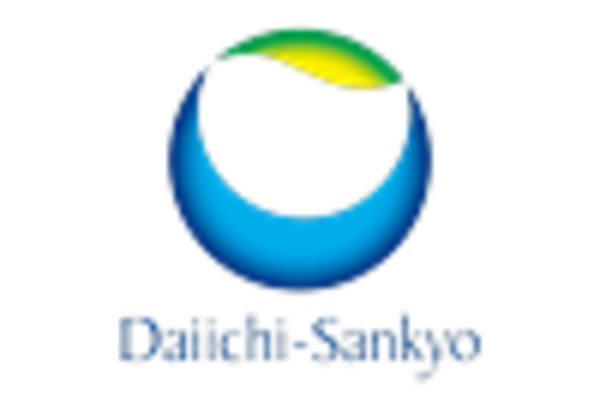Rising Demand for Biologics
The increasing demand for biologics in the pharmaceutical sector is a key driver for the Pharmaceutical Dye Market. Biologics, which are derived from living organisms, often require specific dyes for identification and quality control. As the market for biologics expands, the need for specialized dyes that can meet regulatory standards and ensure product safety becomes paramount. In 2025, the biologics market is projected to reach approximately 500 billion USD, indicating a substantial growth trajectory. This surge in demand for biologics is likely to propel the Pharmaceutical Dye Market, as manufacturers seek to develop dyes that are compatible with these complex products.
Innovations in Dye Technology
Technological advancements in dye production and application are transforming the Pharmaceutical Dye Market. Innovations such as nanotechnology and bio-based dyes are emerging, offering enhanced performance and reduced environmental impact. These advancements not only improve the efficacy of dyes but also align with sustainability goals within the pharmaceutical sector. As companies increasingly prioritize eco-friendly solutions, the demand for innovative dye technologies is likely to rise. In 2025, it is anticipated that the market for advanced dye technologies will account for a significant portion of the overall pharmaceutical dye expenditure, indicating a shift towards more sustainable practices.
Growth of the Generic Drug Market
The expansion of the generic drug market significantly influences the Pharmaceutical Dye Market. As patents for branded drugs expire, generic alternatives emerge, often requiring the use of dyes for branding and differentiation. The generic drug market is expected to grow at a compound annual growth rate of around 7% through 2025, reflecting a robust demand for cost-effective alternatives. This growth presents opportunities for dye manufacturers to cater to the needs of generic drug producers, who seek high-quality dyes that can enhance product visibility and appeal. Consequently, the Pharmaceutical Dye Market is poised to benefit from this trend.
Regulatory Compliance and Quality Assurance
Regulatory compliance remains a critical driver for the Pharmaceutical Dye Market. Stringent regulations imposed by health authorities necessitate the use of approved dyes in pharmaceutical products. These regulations ensure that dyes used in drug formulations meet safety and efficacy standards. As the industry evolves, the need for dyes that comply with these regulations is likely to increase. In 2025, it is estimated that the pharmaceutical sector will invest over 10 billion USD in quality assurance processes, which includes the procurement of compliant dyes. This investment underscores the importance of regulatory adherence in driving the demand for pharmaceutical dyes.
Increasing Focus on Patient-Centric Solutions
The shift towards patient-centric solutions in healthcare is driving changes in the Pharmaceutical Dye Market. As pharmaceutical companies aim to enhance patient experience and outcomes, the use of dyes in personalized medicine is becoming more prevalent. Dyes are utilized in various applications, including imaging and diagnostics, which are essential for tailored treatment plans. The market for personalized medicine is projected to reach 2 trillion USD by 2025, highlighting the growing importance of customized healthcare solutions. This trend is likely to create new opportunities for dye manufacturers to develop specialized products that cater to the evolving needs of the pharmaceutical industry.


















Leave a Comment